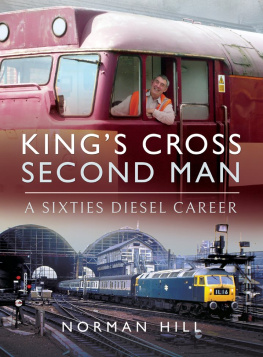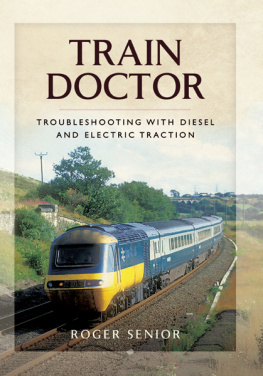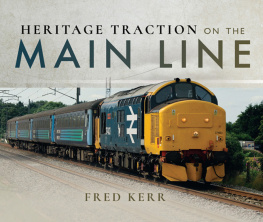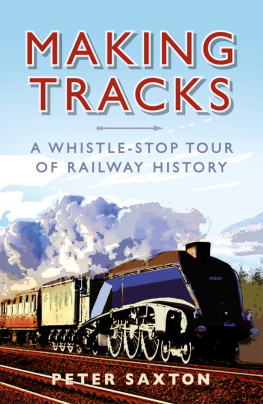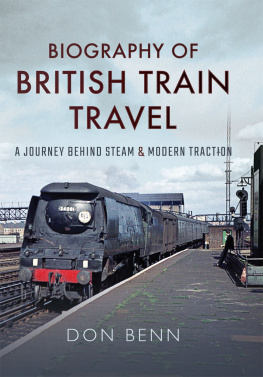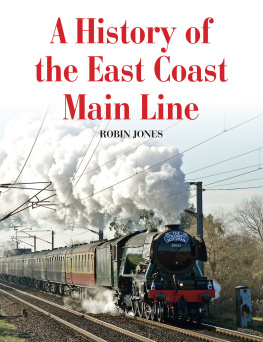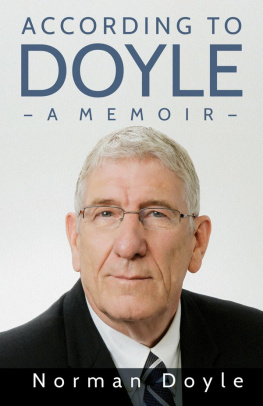
KINGS CROSS SECOND MAN
A SIXTIES DIESEL CAREER
KINGS CROSS SECOND MAN
A SIXTIES DIESEL CAREER
Norman Hill

First published in Great Britain in 2018 by
Pen and Sword Transport
An imprint of
Pen & Sword Books Ltd
Yorkshire - Philadelphia
Copyright Norman Hill, 2018
ISBN 978 1 47387 823 5
eISBN 978 147387 825 9
Mobi ISBN 978 1 47387 824 2
The right of Norman Hill to be identified as Author of this work has been asserted by him in accordance with the Copyright, Designs and Patents Act 1988.
A CIP catalogue record for this book is available from the British Library.
All rights reserved. No part of this book may be reproduced or transmitted in any form or by any means, electronic or mechanical including photocopying, recording or by any information storage and retrieval system, without permission from the Publisher in writing.
Pen & Sword Books Ltd incorporates the Imprints of Pen & Sword Books Archaeology, Atlas, Aviation, Battleground, Discovery, Family History, History, Maritime, Military, Naval, Politics, Railways, Select, Transport, True Crime, Fiction, Frontline Books, Leo Cooper, Praetorian Press, Seaforth Publishing, Wharncliffe and White Owl.
For a complete list of Pen & Sword titles please contact
PEN & SWORD BOOKS LIMITED
47 Church Street, Barnsley, South Yorkshire, S70 2AS, England
E-mail:
Website: www.pen-and-sword.co.uk
or
PEN AND SWORD BOOKS
1950 Lawrence Rd, Havertown, PA 19083, USA
E-mail:
Website: www.penandswordbooks.com
ACKNOWLEDGEMENTS
For photographs I am indebted to :
Justin Bailey for allowing me to reproduce his view of the parting of the ways between the Widened Lines and the road up Snow Hill Bank to The South at Farringdon, Paul Chancellor of Colour-Rail for his advice and assistance, Revd Tom Gladwin RCTS Hitchin member who provided the fine shot of new Hitachis coming up out of Welwyn tunnels and through Welwyn North station. Special thanks to Paul Hepworth for his permission to show the essential images which he took during his part in the preparations for the new ECML South electric railway of the 1970s and also to John Broughton , custodian of the RCTS photo-archive, notably for his most speedy despatches from far away Grange-over-Sands.
For the wonders of todays websites I am especially grateful to the patient researches of :
Nick Catford and his colleagues in their most comprehensive Disused Stations site; David Hills and his amazingly detailed researches into Derby Sulzers; David Heys immense collection of everything railway, and quite a few sites dealing with the histories of modern railway traction manufacturers.
I must mention Golden Eagle Luxury Trains site which grew out of the 1963 Altrinchamian Railway Excursion Society whos early 1966 Flying Scotsman hauled Elizabethan venture I saw climb past Ashburton Grove cum Emirates Stadium on that memorable Saturday morning. They run exotic rail tours to parts of the world undreamed of.
I must also be grateful for the patience of my commissioning editor John Scott-Morgan in the south and production manager Janet Brookes in the north; in the north also Dom Allen who patiently turned my pencilled scribblings of the lines from Kings Cross into comprehensible route maps. I am grateful also to the patience of my wife, Joy, for not getting out and about so much during these last few months.
Finally I must offer eternal thanks to Driver Roy Head of Kings Cross who is unfortunately no longer around to receive them but who I will always remember as the best work-mate I ever had.
Norman Hill
August 2018.
PREFACE
I wanted to be an engine driver when I was 8. I wanted to leave school and do this when I was 15. But things called G.C.E. exams thwarted that plan. Ten years later I realised this ambition when I just beat the age barrier to become a second-man, diesel locomotives, Kings Cross. Although it was a job which only lasted some four years it was the only job of my many which was more than just a job. I recorded every shift I worked in foolscap diaries; times attended, drivers with, locomotives worked, diagrams booked, what actually occurred. That was just 50 years ago now; but those few years still stand clear in my memory, and some events are still as vivid as if they had happened yesterday.
But as I prepared to write up and share these memories I realised that there could be much more in them than the mere repetition of my shifts worked on diesel locomotives, for those locomotives in the mid-1960s were still a new form of motive power, they had only recently replaced about 150 years of steam power, and although my journeys rarely took me far from Kings Cross they took me through over a century of Kings Cross Area railway history and into railway places now long gone; the many goods and carriage sidings, forgotten goods and passenger stations, much changed Kings Cross station itself. And I was second man at a time when modernisation was actually rewriting railway history, a process which is still the case today when the current Railway Upgrade Plan is busily building a new national railway system, not the least of which is a brand new railway for the East Coast Main Line and the Kings Cross Area. I have incorporated brief histories of these now long gone railway places and also accounts of the new railways of 50 years ago and today into my account of the small part I played in the railway modernisation of the 1960s.

One of Gatesheads big Sulzers an Eastern Peak, sadly failed, opens my account in late 1964. Here, some ten years later, a sister Peak thunders out of Hadley South tunnel and through Hadley Wood station under the new overhead electric wires on the climb out of London, still in front-line ECML service but surely towards the end of her days. (Colour-Rail)


Gateshead Peak D174, sister to the cause of my initial discomfort on the Passenger Loco, drops back past Kings Cross box onto a Summer 1965 departure in platform 5; both alert second-man and keen young enthusiast whos bunked onto York Road platform keep a sharp look out. (RCTS)
CHAPTER 1
KINGS CROSS - PASSED CLEANER
O ne of Gatesheads big Sulzers, an Eastern Peak (TOPS class 46), had failed, almost, but not quite, on Kings Cross Passenger Locos exit stops, just enough for its north end bogie to be skewed on the curve of the approach road to the stops out of the shed yard. She had died completely, would not answer to the starter at all. Theyd brought a Brush-4 (47) down on top of the failed Peak in order to couple them. As there wasnt room for the two big engines to approach the exit stops together, the Brush would then drag the Peak back into the middle of the shed yard before propelling out past the exit stops into the milk-yard - usually the way onto the shed - thence rightaway to Clarence Yard, Finsbury Park TMD; an apparently easy solution to an inconvenient situation. But when the Brush came up to the skewed north end of the Peak to be coupled, of course the Brushs south end was also skewed on the curved approach to the exit stops, thus while buffers touched on the inside of the curve, a considerable gap yawned between the outside buffers of the two locos. It was somewhere between 1 and 2 a.m. on a mercifully dry November morning in 1964 when one of Kings Cross MPDs rawest recruits was sent down from the crew room on platform 10 (todays 8) to assist in the resolution of this situation. Passed-cleaner Hill, the foreman called into the room where some half dozen shed-duty men whiled away their time, some hoping something would turn up, others, with only a couple of hours to go, fervently hoping the rest of their shift would not produce a job. It was my first duty in the exalted capacity of passed cleaner, having only the week before passed out in basic signalling, hand and lamps, and had been deemed capable of preparing and running locomotive steam heating boilers, and, as I was about to find out in no uncertain manner, of coupling locomotives to trains and together. I stood up attentively. Go down to the Passenger Loco, continued the inside foreman, and act as a rider on a failed engine to Clarence Yard. Even with my 25 years, a lifetime, of railway enthusiasm, I wasnt exactly sure what this order involved, but obediently descended the stairs from the room and walked quickly along to the end of platform 10.
Next page
